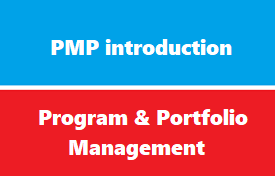introduction
project management lead us to new bigger picture : Program Management & Portfolio Management
Program Management
Program Management
- A Program is a group of related projects managed in coordinated way to obtain benefits and control not available from managing them individually.
- Program management is the centralized, coordinated management of a group of projects to achieve the program’s strategic objectives and benefits.
program manager duties
- Responsible for all non-project-specific paperwork / bureaucratic duties
- Responsible for coaching the PMs below him
- Accountable for the overall performance of their projects, along with PMs
- Support a project whenever the PM isn’t available
- Work as an escalation point from the PM
simply :Program Manager main work is to support Project Manager(s)
The Benefits of Program Management
benefits of program management include:
- Less conflict among projects
- Optimal utilization of resources
- Resource constraints are minimized
- Better communication and coordination among projects
- Improved organizational performance
Portfolio Management
Portfolio Management
- A Portfolio is a collection of projects or programs and other work that are grouped together to facilitate effective management of that work to meet strategic business objectives.
- Portfolio management is the centralized management of one or more portfolios, which includes identifying, prioritizing, authorizing, managing, and controlling projects, programs and other related work.
The Benefits of Portfolio Management
benefits of portfolio management include:
- Optimal allocation and utilization of resources among projects or programs
- Constant support to projects or programs
- Fewer conflicts and better communication among projects or programs
- Better coordination among projects or programs
Types of Portfolio Management
There are majorly four types of portfolio management methods:
- Discretionary portfolio management: In this form, the individual authorizes the portfolio manager to take care of his financial needs on his behalf.
- Non discretionary portfolio management: Here the portfolio manager can merely advise the client what is good or bad, correct / incorrect for him, but the client reserves the full right to take his own decisions.
- Passive portfolio management: It is the form which involves only tracking the index.
- Active portfolio management: This includes a team of members who take active decisions based on hard core research before investing the corpus into any investment avenue. (e.g. close ended funds).
Projects and Strategic Planning:
Projects are often utilized as a means of achieving an organization’s strategic plan. Projects are typically authorized as a result of one or more of the following strategic considerations:
- Market demand
- Strategic opportunity/business need
- Social need
- Environmental consideration
- Customer request
- Technological advance
- Legal requirements
Objectives of Portfolio Management
- It is aptly put as the customization of the investment needs catered by the portfolio managers as per the defined requirements.
- Portfolio management helps in providing the best options for investments to individuals as per the defined criterions of their income, budget, age, holding period and risk taking capacity.
- This is mainly done by the Portfolio managers who understand the investors’ financial needs and accordingly suggest the investment policy that would have maximum returns with minimum risks involved. Aptly put, it is risk reduction through diversification.
- This is the method preferred by those who believe in having liquidity in investments so that one can get the money back when needed.
- Some of the portfolio management schemes are also done for tax saving purposes.
- It helps the investors maintain the purchasing power.
project management vs portfolio management
- Project management focuses on an individual project’s road to completion,
- While portfolio management takes into consideration every project or potential project and its viability to meeting overall business goals.

